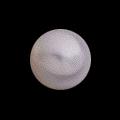

Occurence:
Japan, China, Scotland
and the United states.
Appearance:
Natural pearls are formed
when a foreign object enters the shell of a mollusc and irritates the soft
mantle tissue within.
This irritant can be anything from a minute snail, worm, fish or crab to
a particle of shell clay or mud. This object becomes trapped in a depression
in the mantle tissue. This
depression deepens until
a pouch or sac is formed. The sac separates from the rest of the tissue
and
nacre-secreting cells
within the sac secrets nacre over the irritant. This nacre builds up layer
by layer.
All of this occurs without
the intervention of man what-so-ever. Most of these natural pearls are
baroque - irregular in
shape, neither round or symmetrical. The longer the pearl remains in the
mollusc, the more layers
of nacre coat it. The pearl grows and so does its chance of becoming
baroque. Natural pearls
are always of the saltwater variety.
Something
Extra:
The pearl is the oldest
known gem, and for centuries it was considered the most valuable. To the
ancient civilizations
pearls were a symbol of the moon and had magical powers which could bring
prosperity and long life.
All down through history
pearls were thought to be divine, more suited to royalty than common folk,
but today pearls are often given to the bride on her wedding day because
pearls symbolize purity
and innocence. In the
modern Hindu religion the presentation of an undrilled pearl and its piercing
has formed a part of
the marriage ceremony.
Pearls, in some cultures,
are known for their medicinal qualities. The Chinese use them to cure a
large number of ailments,
some of which include heart disease, indigestion, and some types of fever.